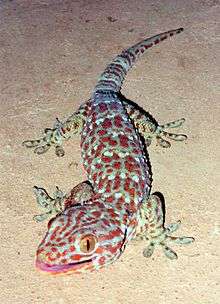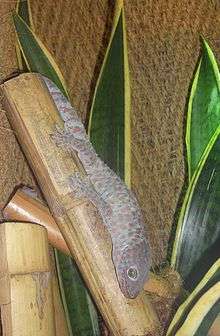Tokay gecko
Gekko gecko, the tokay gecko,[1] is a crepuscular arboreal gecko in the genus Gekko, the true geckos. It is native to Asia and some Pacific Islands.
| Tokay gecko | |
|---|---|
 | |
| Scientific classification | |
| Kingdom: | Animalia |
| Phylum: | Chordata |
| Class: | Reptilia |
| Order: | Squamata |
| Family: | Gekkonidae |
| Genus: | Gekko |
| Species: | G. gecko |
| Binomial name | |
| Gekko gecko | |
| Synonyms | |
Distribution and habitat
This species occurs in northeast India, Bhutan, Nepal, and Bangladesh, throughout Southeast Asia, including the Philippines, Malaysia and Indonesia, and to western New Guinea. Its native habitat is rainforest, where it lives on trees and cliffs, and it also frequently adapts to rural human habitations, roaming walls and ceilings at night in search of insect prey. This is an introduced species in some areas outside its native range. It is established in Florida in the United States, Martinique, the islands of Belize, and possibly Hawaii.[2]. Increasing urbanization is reducing its range.
It is currently unclear whether the species is native but very uncommon in Taiwan, or whether the rare reports of individuals since the 1920s are based on repeated anthropogenic translocations that may or may not have resulted in established populations by now.[3]
Physical characteristics and behavior
_adult_male_and_juvenile.jpg)

The tokay gecko is a large gecko, reaching a total length (including tail) of up to 30 cm (12 in). It is cylindrical but somewhat flattened in body shape. The eyes have vertical pupils. The skin is soft to the touch and is generally gray with red speckles, but the animal can change the color of its skin to blend into the environment. The species is sexually dimorphic, the males being more brightly colored and slightly larger.[4]
Tokay geckos are generally aggressive, territorial, and can inflict a strong bite. Females lay clutches of one or two hard-shelled eggs and guards them until they hatch. The tokay gecko feeds on insects, fruit, vegetation and small vertebrates.[4][5]. It is a strong climber with foot pads that can support the entire weight of the body on a vertical surface for a long period of time. Compared to other gecko species, the tokay gecko has a robust build, with a semi-prehensile tail, a large head and muscular jaws. Though common in the pet trade, the strong bite of the tokay gecko makes it ill-suited for inexperienced keepers.[6] In addition, the strength of the bite depending on the gecko's size; larger (usually male) tokay geckos are capable of piercing skin, which often result in immediate bleeding.
Call
The male's mating call, a loud croak, is variously described as sounding like token, gekk-gekk, tuck-too or poo-kay from which both the common and the scientific name (deriving from onomatopoeic names in Malay, Sundanese, Tagalog, Thai, or Javanese), as well as the family name Gekkonidae and the generic term gecko come. Most of the time, the call is often preceded by a quick "cackling", similar to the chirping sounds made by house geckos albeit much lower in pitch. When threatened or alarmed, tokay geckos usually "bark" while opening its mouth in defensive posture.
The tokay gecko's call is also responsible for a slang name given to it by U.S. soldiers during the Vietnam War: the fuck-you lizard.[7][8]
Conservation
The tokay gecko is culturally significant in many East Asian countries. Regional folklore has attributed supernatural powers to the gecko. In Southeast Asia it is a symbol of good luck and fertility.[4] It is believed to be descended from dragons.[9]
This species is poached for the medicinal trades in parts of Asia.[10] The tokay gecko is an ingredient in Traditional Chinese medicine known as Ge Jie (蛤蚧). It is believed to nourish the kidneys and lungs, beliefs that are not substantiated by medical science. The animal remains highly sought after in China, Hong Kong, Taiwan, Vietnam, Malaysia, Singapore and other parts of Asia with Chinese communities, to the point where unscrupulous merchants have taken to disfiguring monitor lizards with prosthetics to pass them off as colossal tokay gecko specimens.[9]
The tokay gecko is quickly becoming a threatened species in the Philippines due to indiscriminate hunting. Collecting, transporting and trading in geckos without a license can be punishable by up to twelve years in jail and a fine of up to Php 1,000,000.00 under Republic Act 9147 in addition to other applicable international laws.[11] However, the trade runs unchecked due to the sheer number of illegal traders and reports of lucrative deals. Chinese buyers and other foreign nationals are rumored to pay thousands of dollars for large specimens, because of their alleged medicinal value or as commodities in the illegal wildlife trade.[12]
Subspecies
Two subspecies are currently recognized.[13]
- G. g. gecko (Linnaeus, 1758): tropical Asia from northeastern India to eastern Indonesia.
- G. g. azhari Mertens, 1955: found only in Bangladesh.
References
- Stuart, B.; Neang, T.; Phimmachak, S.; Lwin, K.; Thaksintham, W.; Wogan, G.; Thaksintham, W.; Iskandar, D.; Yang, J. & Cai, B. (2019). "Gekko gecko". IUCN Red List of Threatened Species. 2019: e.T195309A2378260. Retrieved 15 January 2020.
- Tokay Gecko (Gekko gecko) established on South Water Caye, Belize. BiologicalDiversity.info.
- Norval, G.; Dieckmann, S.; Huang, S. C.; Mao, J. J.; Chu, H. P.; Goldberg, S. R. (2011). "Does the tokay gecko (Gekko gecko [Linnaeus, 1758]) occur in the wild in Taiwan". Herpetology Notes. 4 (1): 203–205.
- Corl, J. 1999. Gekko gecko. Animal Diversity Web. University of Michigan. Accessed February 19, 2016.
- https://www.reptilecentre.com/info-tokay-gecko-care-sheet
- Baldwin, R. Tokay Gecko Information. Reptile Magazine.
- Dalzell, Tom (2014). Vietnam War Slang: A Dictionary on Historical Principles. Routledge. p. 63. ISBN 978-0-415-83940-2.
- Wise, E. Tayloe (2004). Eleven Bravo: A Skytrooper's Memoir of War in Vietnam. McFarland. p. 59. ISBN 0-7864-1916-4.
- Naish, D. People are modifying monitors to make gargantuan geckos. Scientific American Blog 16 April 2015.
- Stuart, Bryan L. (2004). "The harvest and trade of reptiles at U Minh Thuong National Park, southern Viet Nam" (PDF). Traffic Bulletin. 20 (1): 25–34.
- Illegal trading of gecko poses threat to environment. ASEAN Centre for Biodiversity.
- Agence France-Presse (12 July 2011). "Jail warning to save Philippine geckos". Philippine Daily Inquirer. Retrieved 7 July 2015.
- Gekko gecko at the Reptarium.cz Reptile Database
External links
| Wikimedia Commons has media related to Gekko gecko. |
| Wikispecies has information related to Gekko gecko |
- Tokay Gecko. EcologyAsia.
- Tokay Gecko Care. TokayGecko.org
- The sound of a Balinese geko in Sanur. Recorded October 2004. SoundCloud.
- Nonnatives - Tokay Gecko. Florida Fish and Wildlife Conservation Commission.
